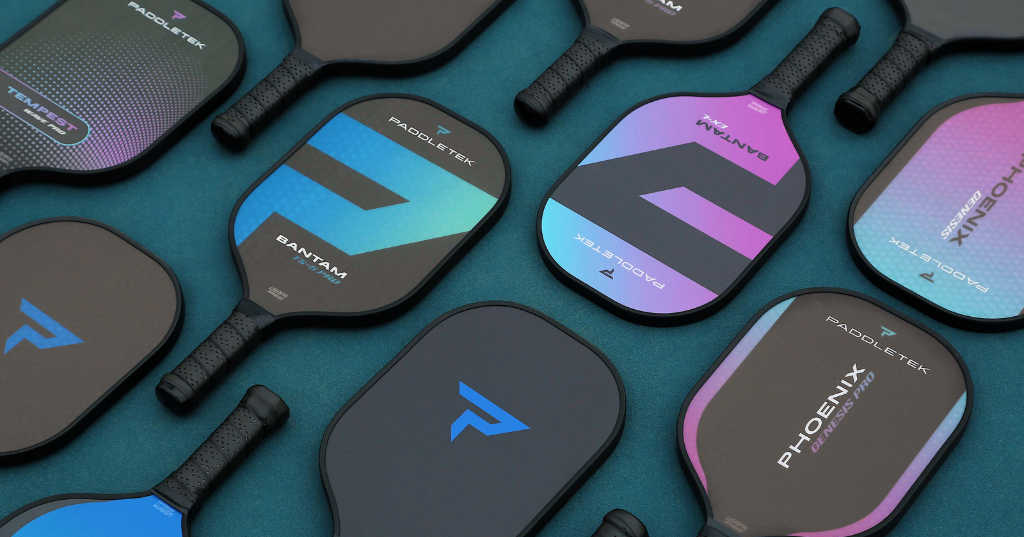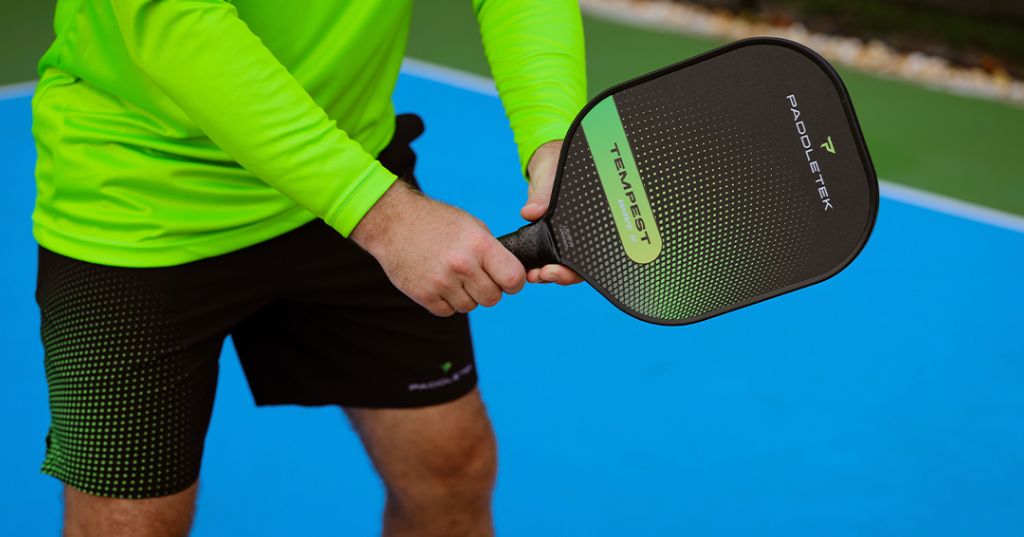The beauty of playing pickleball is how quickly someone can learn the basics, begin playing, and more importantly, start having fun. This is thanks in large part to a set of simple rules and common mechanics. But there's one glaring exception that needs to be addressed, and that's hands down anything to do with the kitchen.
Aside from a name that confuses most, it's the rules of the kitchen that's confounded players of all experience levels since 1965. We think it's high time to debunk the myths surrounding pickleball kitchen rules, and that's precisely what this article will do.
We'll cover the basics of pickleball's kitchen, walk through the actual rules straight from the source, and finally answer the most common questions perpetuating the misinformation. Grab your magnifying glass, because you're about to see the details of the kitchen's rules.
Pickleball Kitchen Rules Explained - What is the Kitchen in Pickleball?
The seven-foot zone on each side of the net is known as the non-volley zone, more commonly referred to as “the kitchen” of a pickleball court. Players are not permitted to volley while standing in it. The kitchen rule exists to prevent a player from standing at the net and smashing every hit.
In other words, the kitchen zone prohibits players from volleying the ball within its boundaries while any part of their bodies is touching the surface of the kitchen. The kitchen is a 2D area, not 3D - this is important because so long as your feet (or any object/article of clothing you possess) are behind the surface of the kitchen, you can volley above the kitchen.
If a player is technically in the kitchen area, they must either wait for the ball to cross outside of the kitchen before volleying or make sure it bounces off the ground before hitting it in the kitchen.
Failure to follow this rule results in a fault, awarding the rally to the time without the fault. Depending on who is serving, this could either result in a point or loss of serve.
Let's take one step back from the kitchen line and talk about volleys.
What is a Volley?
Simply put, a volley is when you hit the ball without letting it bounce. Volleys are also sometimes referred to as “overheads” or “smash shots” because of their explosive power and speed. Volley shots can be performed from any position on the court, provided they are not done within the kitchen.
Volleys aren't exclusive to pickleball, they are an important component of other paddle and racquet sports. And although there are restrictions about where you can volley in pickleball, they are still an instrumental part of playing the game.
And this is where the confusion starts to set in.
Can You Ever Step in the Kitchen in Pickleball?
Yes! As long as you are not volleying while standing in the non-volley zone, it's perfectly legal to stand anywhere in the kitchen. In doubles in particular, it's best to stand around the kitchen line, which is great positioning for volleying, but also the ability to reach soft shots.
This is a source of confusion for many new players because they interpret the kitchen (non-volley zone) as an area to never step foot in. Which you now know is false. You can step in it, dance in it, do the do-si-do - but you just can't volley while standing in the kitchen.
Can You Go into the Kitchen Before the Ball Bounces?
Yes! You just cannot volley the ball in the kitchen - meaning you could step in it, but before you hit the ball, you would need to have both feet outside of the kitchen before you volley, in addition to all other rules of the kitchen, or you would need to make sure the ball bounces before hitting it.
We're sure you're starting to sense a theme at play here. But don't take our word for it, let's look at the book of pickleball kitchen rules.
Can a Pickleball Serve Hit the Kitchen Line?
No, a pickleball serve cannot hit the kitchen line. The kitchen includes its demarcation line, referred to formally as the Non-Volley Zone line, but more simply as the kitchen line. It also includes all pickleball court lines that bound it, such as the sideline and centerline.
This matters since a toe slipping over the non-volley line can make the difference between a legal volley and one that breaks the kitchen's rules.

Official Kitchen Rules of Pickleball - USA Pickleball
Not to add any extra confusion to the kitchen, but there are more rules surrounding this mythical region of the court besides where you can or cannot legally hit a volley. As we break down the official rules of the kitchen, we'll separate them by how it applies to different parts of a game.
Non-Volley Zone Rules: General Rules of the Kitchen
Flip to section 9 of USA Pickleball's 2023 rule book (page 44) to have all your kitchen questions answered. We'll try our best to break each down into simple terms.
- Rule 9.A. - No volleying while touching the kitchen.
- Rule 9.B. - If you or your body touches any part of the kitchen while volleying, this is a fault. It includes your swing, follow-through, momentum, and even applies to your paddle or anything you're wearing.
- Rule 9.C. - If your momentum or even your partner somehow causes you to enter the kitchen while volleying, that's a fault.
- Rule 9.D. - If you enter the kitchen by any means, you can't volley until both feet are completely back out of the kitchen. This includes entering and jumping in the air to land behind the kitchen while volleying - this would result in a fault as well.
- Rule 9.E. - You can be in the kitchen any time you like, except when volleying.
- Rule 9.F. - You can hit the ball from the kitchen so long as there was a ball bounce first.
- Rule 9.G. - You don't have to leave the kitchen to return a ball if it has bounced first. This means you can stay in the kitchen whenever and however long you like, except for... You guessed it - volleying inside the kitchen.
- Rule 9.H. - If you're standing in the kitchen and your partner returns or volleys the ball legally, this is not breaking the rules of the kitchen.
Momentum: What Does It Mean in Pickleball?
Rules 9.B.1., and 9.C. mention momentum and how it can be a way of breaking the kitchen area, but that's such a nebulous term on its own. Thankfully, USA Pickleball has defined momentum for all of us as rule 3.A.20., which states:
- Rule 3.A.20. - Momentum is a property of a body in motion, such as a player executing a volley, that causes the player to continue in motion after contacting the ball. The act of volleying produces momentum that ends when the player regains balance and control of their motion or stops moving toward the non-volley zone.
In plain English, this is movement, whether intentional or otherwise, that is only reset once you stop that continued motion. If momentum carries you through to touch the kitchen during your volley, this is a fault.
Serving: How the Kitchen Rules Apply
- Rules 4.A.2. and 4.M.5. - The serve may clear or touch the net and must clear the NVZ and the NVZ lines... This ensures that the serve lands only in the service court, which is diagonally opposite to the serving player. That area does not include the kitchen - and since the kitchen includes its line, that's also off-limits.
Partially unrelated, the service court does include every other line that forms its boundary, such as the baseline, sideline, and centerline. Serving has a long list of rules, so be sure to brush up on them as you get more entrenched in the sport. Not doing so is a quick way to earn avoidable faults.
Hopefully, this was a painless and easy-to-understand look at the kitchen and its rules. If you hear anything outside of any of these rules, well, now you know the truth and you can help educate the misinformed.
Common Questions Surrounding the Non-Volley Zone
You may hear some questions that aren't directly covered in the strict rules, but based on what we've just discussed, you can interpret an accurate answer. We've laid them out for you below.
Can You Jump and Land in the Kitchen in Pickleball?
You can jump and land in the kitchen in pickleball so long as you aren't hitting the ball as a volley. This would be a fault if your body is in the act of volleying and your momentum lands in the kitchen. If the ball has bounced first, or you just feel like jumping in, this would not violate volley motion.
That said, since the kitchen is a two-dimensional space, so long as you begin your jump outside of the kitchen and land outside of the kitchen, you can volley over the kitchen. This is referred to as an erne - most often this happens near the sidelines where a player can make a diagonally jump, and volley the ball in mid-air.
If you begin inside the kitchen and land inside or outside of the kitchen while volleying during your jump, this is considered a fault. For more information on momentum, review rule 3.A.20. outlined earlier in this article.
What Can You Not Do in the Kitchen In Pickleball?
There are two things you cannot do in the kitchen in pickleball. First, you cannot volley while standing in the kitchen, this also accounts for your body, or paddle, or any part of you that has momentum touches the kitchen during a volley shot. Secondly, a serve cannot land in the kitchen.
When Can You Go into the Kitchen in Pickleball?
You can go into the kitchen at any point during a game. You can even hit from the kitchen, so long as the ball hits the ground first. You can also be in the kitchen while your partner volleys outside of the kitchen. The only time you cannot be in the kitchen is during the act of volleying the ball.




Leave a comment
This site is protected by hCaptcha and the hCaptcha Privacy Policy and Terms of Service apply.